Nail polish (also known as nail varnish) is a lacquer that can be applied to the human fingernail or toenails to decorate and protect the nail plates. The formulation has been revised repeatedly to enhance its decorative effects, and to suppress cracking or flaking. Nail polish consists of a mix of an organic polymer and several other components, depending on the brand. People use this liquid to create simple or complicated designs with bright colors, charms, or other.
Your Nail! Whats Say About Your Health!
The health risks associated with nail polish are disputed. According to the U.S. Department of Health and Human Services, “The amount of chemicals used in animal studies is probably a couple of hundred times higher than what you would be exposed to from using nail polish every week or so. So the chances of any individual phthalate producing such harm [in humans] are very slim.”A more serious health risk is faced by professional nail technicians, who perform manicures over a workstation, known as a nail table, on which the client’s hands rest – directly below the technician’s breathing zone. In 2009, Susan Reutman, an epidemiologist with the U.S. National Institute for Occupational Safety and Health’s Division of Applied Research and Technology, announced a federal effort to evaluate the effectiveness of downdraft vented nail tables (VNTs) in removing potential nail polish chemical and dust exposures from the technician’s work area. These ventilation systems have the potential to reduce worker exposure to chemicals by at least 50%. Many nail technicians will often wear masks to cover their mouth and nose from inhaling any of the harsh dust or chemicals from the nail products.
According to Reutman, a growing body of scientific literature suggests that some inhaled and absorbed organic solvents found in nail salons such as glycol ethers and carbon disulfide may have adverse effects on reproductive health. These effects may including birth defects, low birth weight, miscarriage, and preterm birth.
Nail polish formulations may include ingredients that are toxic or affect other health problems. One controversial family of the ingredient are phthalates, which are implicated as endocrine disruptors and linked to problems in the endocrine system and increased risk of diabetes. Manufacturers have been pressured by consumer groups to reduce or to eliminate potentially-toxic ingredients, and in September 2006, several companies agreed to phase out dibutyl phthalates. There are no universal consumer safety standards for nail polish, however, and while formaldehyde has been eliminated from some nail polish brands, others still use it.
Nutrients deficiencies that cause nail problems
| Nail problems | Possible nutrient deficiency |
|
Calcium, Vitamin A |
|
Iron, Zinc |
|
Protein, Iron |
|
Zinc, Protein |
|
Vitamin B12 |
|
Folic acid, Protein and Vitamin C |
Food sources that can help your nails

As you are aware, many common nail problems indicate that there is a deficiency of certain vitamins or minerals in your body. If you notice any of these symptoms, you may need to include more of these nutrients in your daily diet.
The main food sources of nutrients related to healthy nails are:
- Milk and dairy products are good sources of protein, calcium, zinc and vitamin B12, and can help keep your nails strong.
- Include lean meat, fish, and chicken in your diet to ensure adequate intake of proteins, iron and zinc. Another good protein-rich food for healthy nails is eggs which are rich in vitamin B12 and folic acid.
- Whenever you can, consume cooked organ meats (liver, Kidney) which are rich in iron, vitamin A, vitamin B12, and folic acid.
- Enrich your diet with legumes (lentils, dried beans etc), which are high in fiber and provides you with protein, zinc, iron and folic acid thus lessening your nails from cracking and developing white spots.
- Increase your intake of green leafy vegetables (spinach, broccoli etc), which are good sources of calcium, folic acid, and vitamin A.
- A daily intake of citrus fruits and vegetables (green pepper, cabbage etc), which are rich in vitamin C are helpful if you are having reddish-brown spots on your nails.
- Strong nails also need vitamin A that is mainly found in yellow or orange vegetables like carrots.
- Biotin is also an essential nail-building material that is found in the liver, meats, milk, egg yolk, and most vegetables.
- Don’t forget to drink enough water (8 glasses a day) to keep your body and your nails completely hydrated.

|
A Guide toHealthy Fingernails: |
|
| Nail Appearance | Associated Condition |
| White nails | Liver diseases such as hepatitis |
| Yellowish, thickened, slow-growing nails | Lung diseases such as emphysema |
| Yellowish nails with a slight blush at the base | Diabetes |
| Half-white, half-pink nails | Kidney disease |
| Red nail beds | Heart disease |
| Pale or white nail beds | Anemia |
| Pitting or rippling of the nail surface | Psoriasis or inflammatory arthritis |
| “Clubbing,” a painless increase in tissue around the ends of the fingers, or inversion of the nail | Lung diseases |
| Irregular red lines at the base of the nail fold | Lupus or connective tissue disease |
| Dark lines beneath the nail | Melanoma |
Ingredients
Nail polish consists of a film-forming polymer dissolved in a volatile organic solvent. Nitrocellulose that is dissolved in butyl acetate or ethyl acetate is common. This basic formulation is expanded to include the following:
- Plasticizers to yield non-brittle films. Dibutylphthalate and camphor are typical plasticizers.
- Dyes and pigments. Representative compounds include chromium oxide greens, chromium hydroxide, ferric ferrocyanide, stannic oxide, titanium dioxide, iron oxide, carmine, ultramarine, and manganese violet.[8]
- Opalescent pigments. The glittery/shimmer look in the color can be conferred by mica, bismuth oxychloride, natural pearls, and aluminum powder.
- Adhesive polymers ensure that the nitrocellulose adheres to the nail’s surface. One modifier used is tosylamide-formaldehyde resin.
- Thickening agents are added to maintain the sparkling particles in suspension while in the bottle. A typical thickener is a stearalkonium hectorite. Thickening agents exhibit thixotropy, their solutions are viscous when still but free-flowing when agitated. This duality is convenient for easily applying the freshly shaken mixture to give a film that quickly rigidifies.
- Ultraviolet stabilizers resist color changes when the dry film is exposed to sunlight. A typical stabilizer is benzophenone-1.
What Are Your Nails Saying About Your Health?
Fingernail changes can be warning signs in regard to your health and should be checked out rather than ignored.
Most of us don’t pay much attention to our fingernails. Even if you polish, primp or manicure your nails, you may not notice a rosy, yellow or pale color, or if there are ripples or ridges developing. But all of these may be warning signs that something is wrong with your overall health.
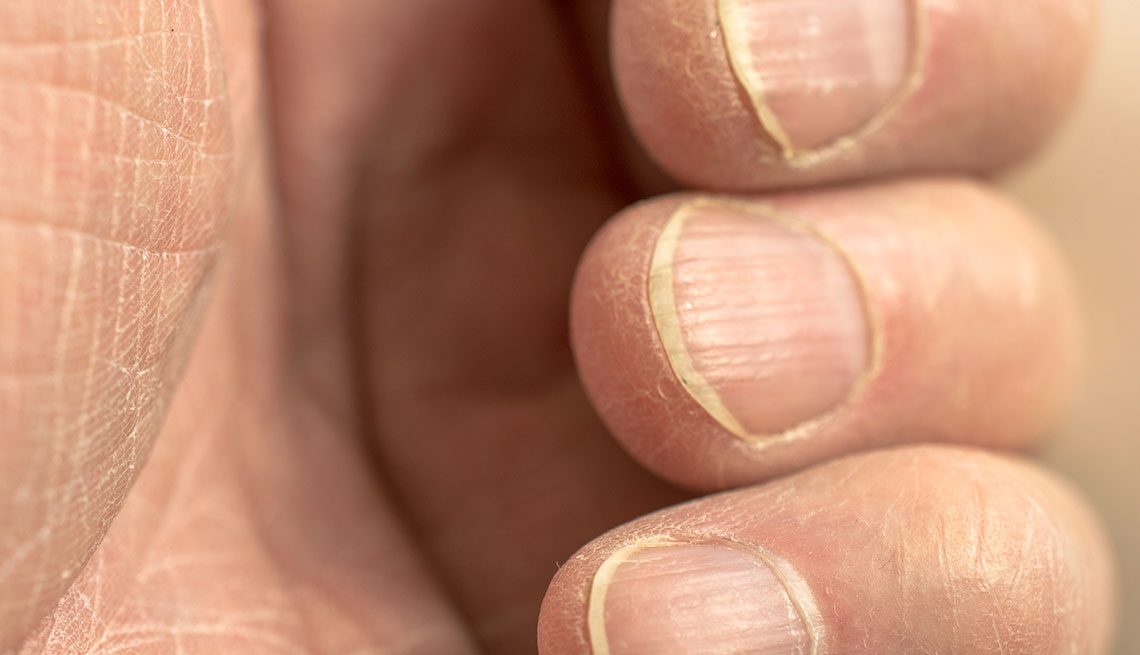
Rippled nails
The surface of your fingernail should be smooth. If you detect ripples or pitting developing, this may be an early warning of psoriasis, eczema or inflammatory arthritis. According to the Healthline.com website, “Iron deficiency anemia can also trigger vertical ridges and changes to your nails that make them concave, or spoon-shaped.” Deficiencies in calcium, zinc or vitamin A can also be the culprit of ridges in fingernails.
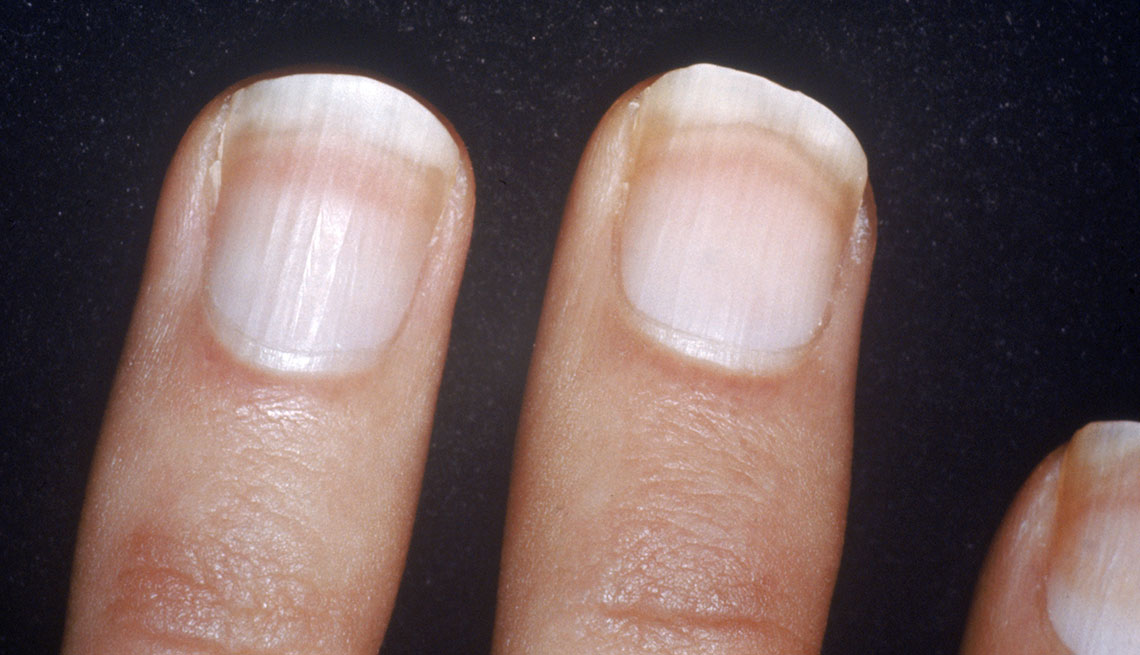
White nails
If the nail bed is predominantly white with darker rims near the top, this can indicate liver problems such as hepatitis. According to WebMD, pale fingernails can also indicate problems with anemia, liver disease or even heart disease.
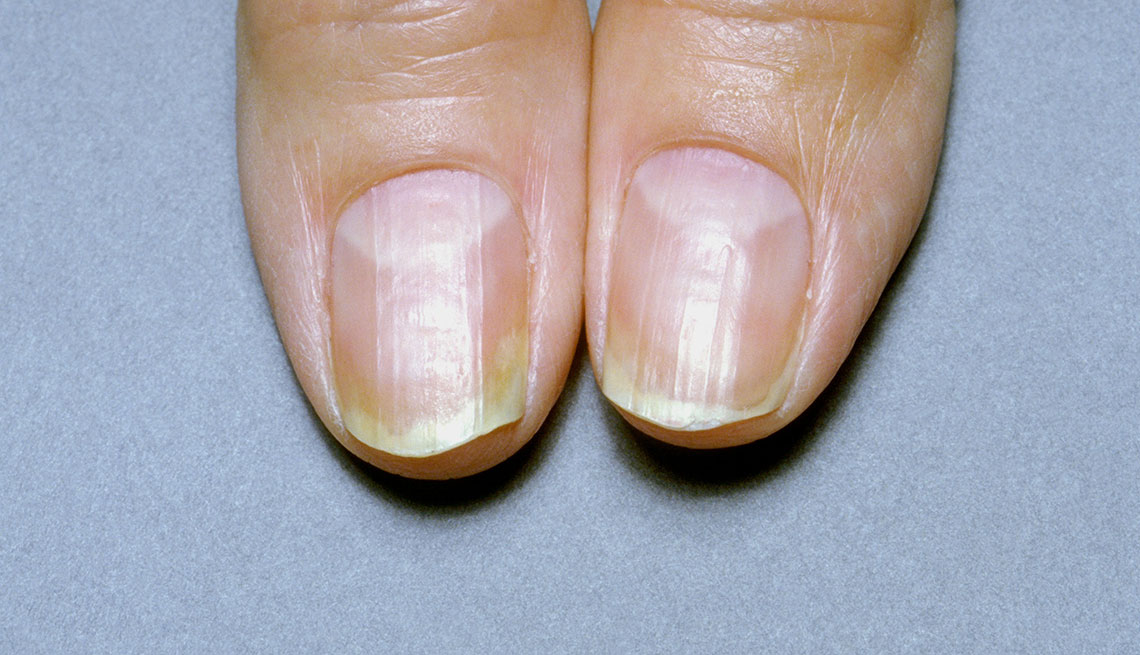
Yellow nails
A fungal infection is the most common cause of yellow nails. If the condition persists, the nails may continue to deteriorate and become thick and crumble. Healthline.com states: “In some cases, nails that remain yellow despite repeated treatment can be a symptom of thyroid conditions, psoriasis, or diabetes. In rare situations, yellow nails can indicate the presence of skin cancer. A condition called yellow nail syndrome (YNS) is indicated by continually yellow nails and respiratory or lymphatic problems.”
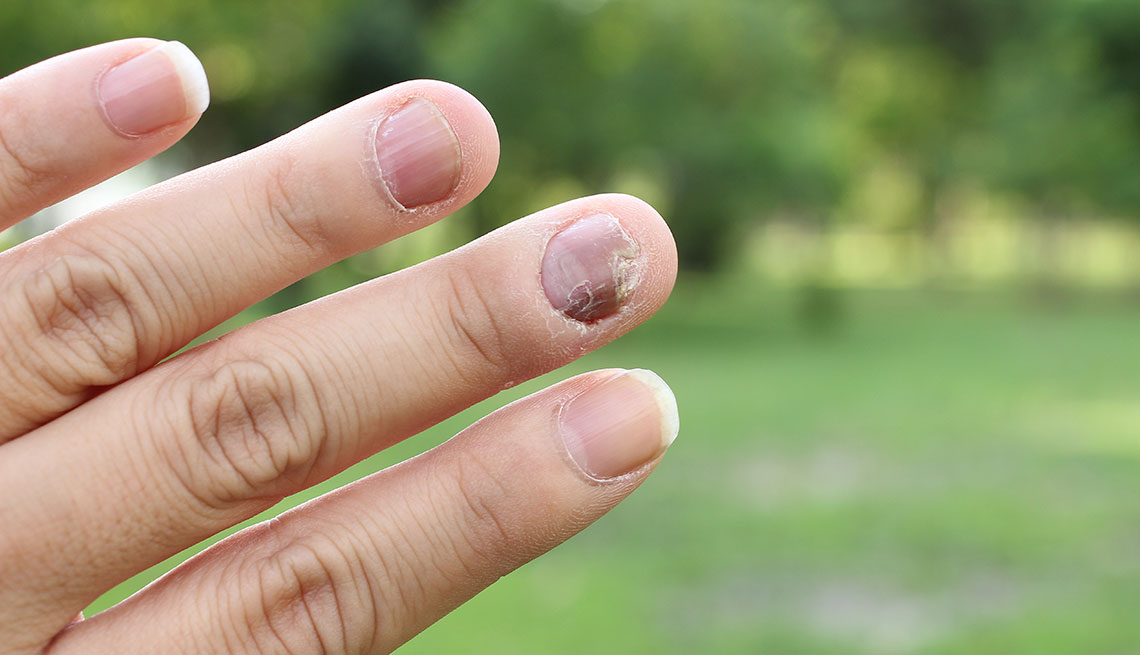
GETTY IMAGES
Split or cracked nails
A combination of splitting and cracking nails can be due to a fungal infection. And if the splitting is not related to damage from chemicals like such as household cleansers, it could be a sign of thyroid disease. According to the Livestrong website, “Splitting nails may be caused by hypothyroidism, a condition in which the thyroid gland is underactive and doesn’t produce enough hormones. Other symptoms of hypothyroidism include weakness, fatigue, unintentional weight gain, joint pain and heavy menstrual periods.”
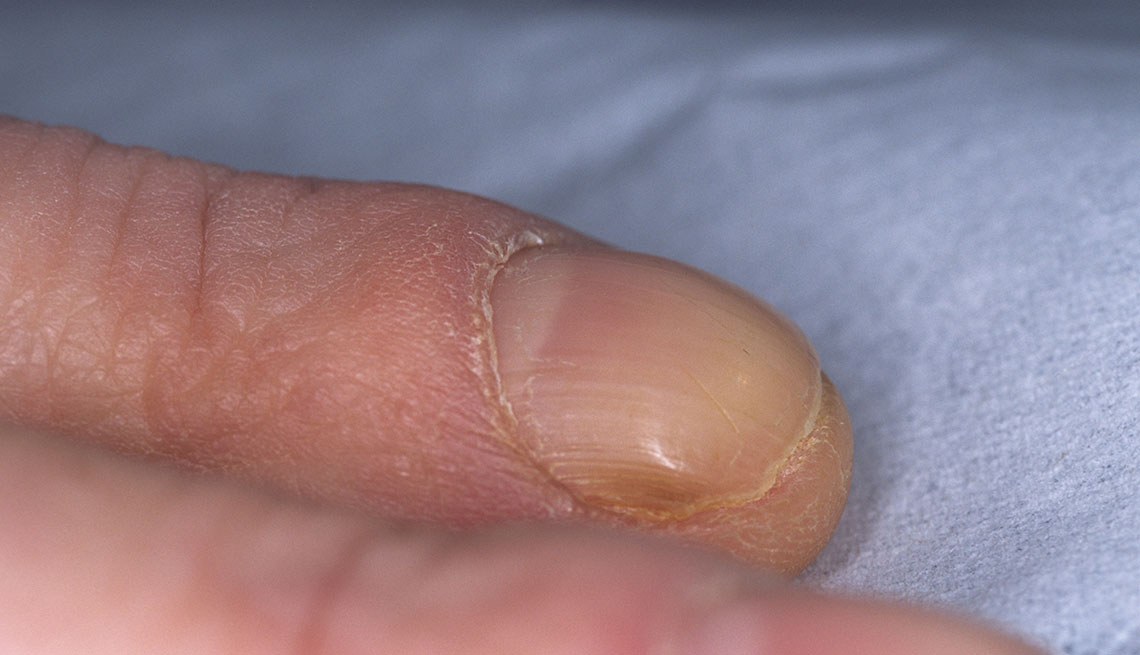
Clubbing nails
Clubbing happens when the nails become rounded and the tips of the fingers swell in size. It is a slow process and can take years before it becomes evident. According to the Mayo Clinic, “Nail clubbing is sometimes the result of low oxygen in the blood and could be a sign of various types of lung disease. Nail clubbing is also associated with inflammatory bowel disease, cardiovascular disease, liver disease and AIDS.”

Puffy nail fold
If puffy skin develops around the nail bed, accompanied with redness and swelling, this could be due to an infection called paronychia. It’s a common infection that can usually be treated with antibiotics. Puffy nail beds can also be a sign of a disorder. According to WebMD, “It may be the result of lupus or another connective tissue disorder.”
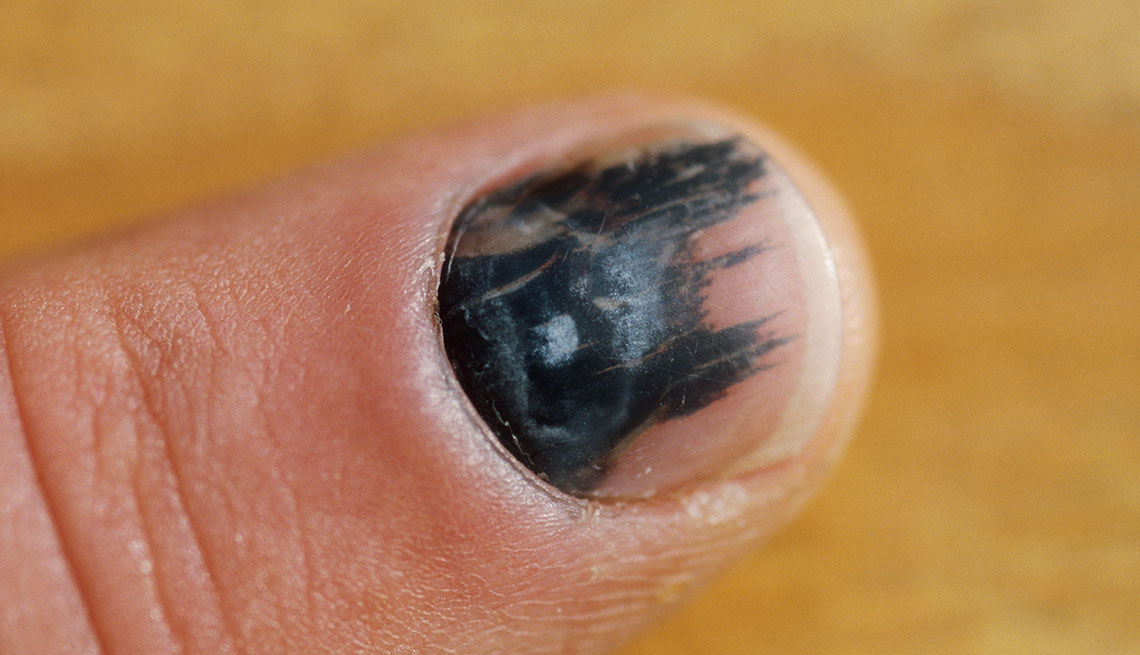
Dark lines beneath the nail
This type of change to your nails can be cause for concern. Dark lines beneath the nail can be due to an injury in which blood can clot underneath the nail and cause dark lines to form. If it is not due to an injury, it should be looked into as soon as possible. WebMD says it can be a sign of cancer: “Dark lines beneath the nail should be investigated as soon as possible. They are sometimes caused by melanoma, the most dangerous type of skin cancer.”

Toenail fungus
Toenail fungus infections are the result of various fungal organisms. Yeast and molds can also lead to nail infections. Athlete’s foot is caused by a number of different fungal infections and can spread from one toe to another. “Toenail fungus can affect anyone but becomes more prevalent with aging,” according to the Very well site. Individuals with certain diseases, such as diabetes and conditions that affect limb circulation, are more susceptible to fungal nail infections, as well as people who have suppressed immune systems.”
Changes to your nails, whether on your fingers or toes, can take place for many reasons. However, it is still important to see your doctor or a dermatologist. Changes can be warning signs in regard to your health and should be checked out rather than ignored.
References



